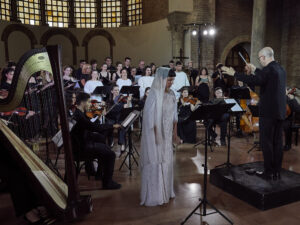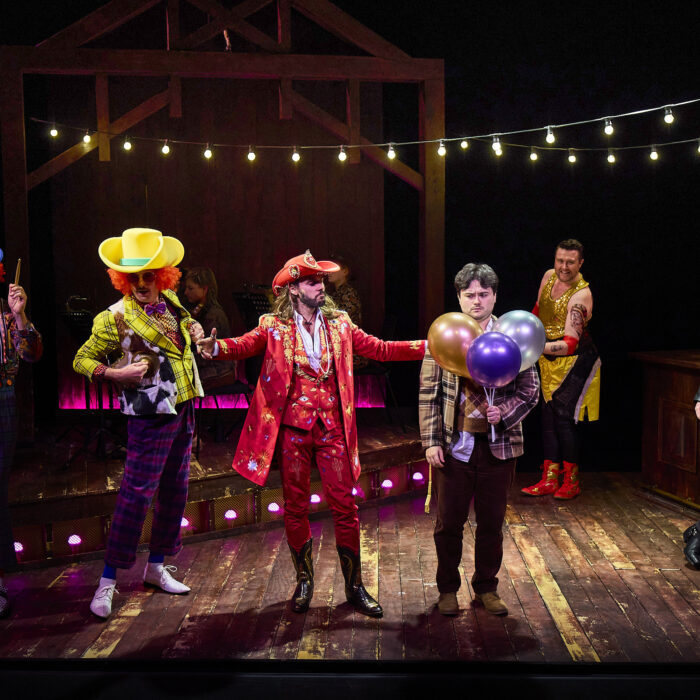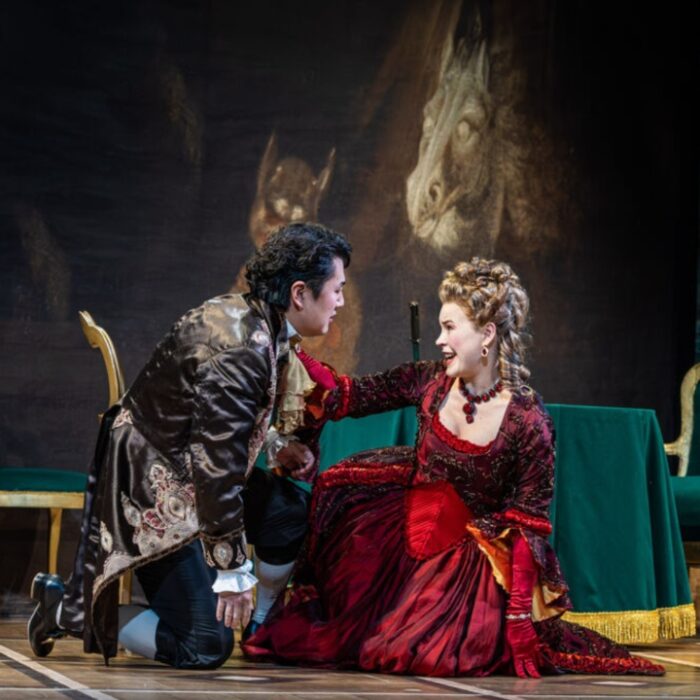
Ravenna Festival 2024 Review: Dilexi
Laura Zecchini Steps Into The Spotlight As Galla Placidia
By Alan Neilson(Photo: Zani-Casadio)
One of the most fascinating people associated with the city of Ravenna is Galla Placidia, a woman born into the imperial family in Constantinople around 390 AD. Daughter of Emperor Theodosius I, sister of Emperor Flavius Honorius, wife of Emperor Constantius III and mother of Emperor Valentinian III, hers was a life lived at the centre of power. It was also a life that coincided with the decline of the empire. She was present at the sack of Rome in 410 AD and carried off as Alaric’s prisoner, only to marry his successor, Athaulf, with whom she had a child. Both, however, were dead by 415 AD.
Soon thereafter, Galla was returned to Italy, where she was forced to marry Constantius III, with whom she had two children, including a son, Valentinian. On Constantius’s death, however, she clashed with her brother, the emperor Honorius, and was forced to flee to Constantinople. On Honorius’ death, Valentinian, now aged five, was nominated as western Roman emperor, with Galla Placidia acting as regent until 437 AD. She turned out to be a forceful, religious and relatively successful regent, particularly in forging agreements with the barbarian tribes and involving herself directly in the politics of the church. She was also responsible for the construction of a number of wonderful buildings in Ravenna, including the famous mausoleum, with its fabulous mosaics, that today bears her name, although she is not buried there. She died while on a pilgrimage to Rome, where she was buried in 450 AD.
On their sea journey from Constantinople back to the imperial court in Ravenna to take up their imperial positions, Galla and Valentinian’s ship was caught in a severe storm, and she was so terrified that she vowed to build a church dedicated to St. John the Evangelist should she survive. The result was the Basilica di San Giovanni Evangalista, which this summer played host to “Dilexi,” a new opera about the life of Galla Placidia by composer Danilo Comitini and librettist Francesca Masi.
A Life Made for the Stage
In many ways, Galla Placidia’s colorful life was ready-made for opera. However, rather than focusing on the high-profile incidents, Comitini and Masi decided to present her life from a religious perspective, with defining events such as the death of her father and the sack of Rome providing an explanatory context.
The work’s title, “Dilexi,” translates as “I loved” and refers to the last word spoken by Galla’s father on his deathbed.
The work comprises seven scenes, each relating to an episode from her life in a different city across the empire and incorporates thoughts from a religious figure. Scene one, for example, is set in Milan at the funeral of her father, Theodosius I, in which Bishop Ambrose delivers the funeral oration and Galla awakens to the power of faith. In scene four, Galla finds herself in Ravenna. Having been forced to marry Constantius, she turned inward and championed the church’s fight against Pelagio, who denied the existence of original sin. The words of St. Augustine of Hippo offer her support. Finally, in scene seven, she meets Pope Leo the Great in Rome, where she dies to be reunited with her father, Theodosius, and her first son, Theodosius, in heaven.
The format for each scene took a similar form, in which the chorus sang a verse in Latin. Galla, singing in Italian, reflected on the situation at hand and mused on its spiritual dimensions with observations from a religious figure. In scene two, for example, Rome is invaded by Alaric’s armies, and Galla calls out to St. Jerome, who advises her to seek solace and wisdom in the scriptures.
Comitini’s score was firmly fixed in the traditions of church music, although his assertive use of the percussion and addition of the accordion gave it a contemporary feel. His ability to write for the choir displayed expertise in developing pleasing harmonies and clearly defined, although not notably memorable, melodies that were well-crafted to suit the acoustics of the church. The musical director Antonio Greco produced a fine performance from the Ensemble 1685 del Conservatorio Giuseppe Verdi di Ravenna, maintaining a pleasing balance between the ensemble, the choir and the soloists and successfully captured the atmospheric aspects of the score. His coaching of the Coro del Conservatorio Giuseppe Verdi di Ravenna ensured its first-class performance.
Zecchini Catches the Attention in a Standout Performance
The star performance, however, was certainly that of soprano Laura Zecchini in the role of Galla Placidia. She possesses an attractive, secure, clear-toned voice, is able to spin out lines of delicate beauty and responded intelligently and sensitively to the text. At times she voiced her pain gently, while on other occasions she was more demonstrative, furnishing the line with strong emotional and dynamic inflections and indulging in agile leaps. Her voice combined sympathetically with the other soloists.
Baritone Gianandrea Navacchia played six of the seven religious characters who interacted with Galla Placidia. He produced a clear, articulate performance that, in line with his characters, was calm and certain. There was nothing overly dramatic about his portrayals; rather, he emphasized the religious natures of his characters.
In scene three, Galla finds herself emotionally shredded by the death of her son Theodosius. A reflection of this is offered by the life of Hypatia of Alexandria, who was torn to pieces by a fanatical mob that hated her beliefs. Hypatia’s words were presented by soprano Camilla Pacchierini in a brightly sung, confident performance, which captured her strong sense of purpose.
The visual side of the presentation was very basic. Apart from a staged entrance and simple, effective costumes, designed by Manuela Monti, that reflected the late classical period with religious connotations, it was essentially a concert performance, which was enhanced by the beautiful and atmospheric venue of the basilica founded by Galla Placidia.
Although “Dilexi” touches only briefly on the details of Galla Placidia’s turbulent life, it proved effective in illustrating the extent to which her religious faith was an inextricable part. It was also a work that was respectful of the Christian message, and as such, it made an excellent piece for performance in a church.



